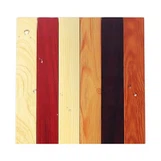Hey there! As a supplier of Honeycomb Aluminum Sheet, I often get asked about its electromagnetic shielding performance. So, let's dive right into it and explore what makes honeycomb aluminum sheet a great choice when it comes to blocking those pesky electromagnetic waves.
Understanding Electromagnetic Shielding
First off, what exactly is electromagnetic shielding? Well, in simple terms, it's the process of blocking or reducing the amount of electromagnetic radiation that passes through a material. Electromagnetic radiation can come from all sorts of sources, like electronic devices, power lines, and even the sun. And while some levels of electromagnetic radiation are harmless, others can interfere with sensitive equipment or pose potential health risks.
That's where electromagnetic shielding comes in. By using materials that can absorb or reflect electromagnetic waves, we can create a barrier that protects us and our devices from unwanted radiation.
How Honeycomb Aluminum Sheet Works for Electromagnetic Shielding
So, how does honeycomb aluminum sheet fit into all of this? Well, honeycomb aluminum sheet is made up of a series of hexagonal cells, which are sandwiched between two layers of aluminum. This unique structure gives honeycomb aluminum sheet some pretty impressive properties when it comes to electromagnetic shielding.
One of the main ways honeycomb aluminum sheet provides electromagnetic shielding is through its conductive nature. Aluminum is a good conductor of electricity, which means it can easily absorb and dissipate electromagnetic waves. When electromagnetic waves hit the surface of the honeycomb aluminum sheet, they induce an electric current in the aluminum. This current then creates a magnetic field that opposes the incoming electromagnetic waves, effectively canceling them out.
In addition to its conductive properties, the honeycomb structure of the sheet also plays a role in electromagnetic shielding. The hexagonal cells act as a series of small cavities, which can trap and reflect electromagnetic waves. This helps to further reduce the amount of radiation that passes through the sheet.
Factors Affecting the Electromagnetic Shielding Performance of Honeycomb Aluminum Sheet
Of course, the electromagnetic shielding performance of honeycomb aluminum sheet isn't just determined by its basic structure. There are a few other factors that can affect how well it blocks electromagnetic waves.
One of the most important factors is the thickness of the aluminum layers. Generally speaking, the thicker the aluminum layers, the better the electromagnetic shielding performance. This is because thicker layers can absorb and dissipate more electromagnetic energy.
Another factor is the size of the honeycomb cells. Smaller cells tend to provide better electromagnetic shielding than larger cells. This is because smaller cells can trap and reflect electromagnetic waves more effectively.
The material used for the honeycomb core can also have an impact on the electromagnetic shielding performance. Some honeycomb cores are made from materials that are more conductive than others, which can improve the overall shielding effectiveness of the sheet.
Applications of Honeycomb Aluminum Sheet for Electromagnetic Shielding
So, where can you use honeycomb aluminum sheet for electromagnetic shielding? Well, there are a lot of different applications where it can come in handy.
One common application is in electronic devices. Many electronic devices, like computers, smartphones, and tablets, generate electromagnetic radiation. By using honeycomb aluminum sheet to line the inside of the device's casing, you can reduce the amount of radiation that is emitted from the device. This can help to protect the user from potential health risks and also prevent interference with other electronic devices.
Honeycomb aluminum sheet is also used in the aerospace industry. Aircraft and spacecraft are exposed to a lot of electromagnetic radiation, both from the sun and from other sources. By using honeycomb aluminum sheet to shield the interior of the aircraft or spacecraft, you can protect the sensitive electronic equipment on board from electromagnetic interference.
Another application is in the construction industry. Honeycomb aluminum sheet can be used to line the walls and ceilings of buildings to provide electromagnetic shielding. This can be particularly useful in buildings that house sensitive electronic equipment, like data centers or hospitals.
Our Honeycomb Aluminum Sheet Products
As a supplier of Honeycomb Aluminum Sheet, we offer a wide range of products that are designed to provide excellent electromagnetic shielding performance. Our Aluminum Honeycomb Panel is made from high-quality aluminum and features a unique honeycomb structure that provides superior shielding effectiveness.
We also offer Fireproof Aluminum Honeycomb Panel, which not only provides excellent electromagnetic shielding but also has fire-resistant properties. This makes it a great choice for applications where fire safety is a concern.


And if you're looking for a more lightweight option, our Aluminum Honeycomb Composite Panel is a great choice. It combines the strength and durability of aluminum with the lightweight properties of a composite material, making it easy to install and transport.
Contact Us for Your Honeycomb Aluminum Sheet Needs
If you're interested in learning more about our honeycomb aluminum sheet products and their electromagnetic shielding performance, or if you have any questions about our products, please don't hesitate to contact us. We'd be happy to help you find the right solution for your specific needs. Whether you're a manufacturer looking to incorporate honeycomb aluminum sheet into your products or a contractor looking for a reliable supplier for your construction project, we've got you covered.
References
- Electromagnetic Compatibility Engineering by Henry W. Ott
- Handbook of Electromagnetic Materials: Principles, Properties and Applications by K. Sreenivas
So, that's a quick overview of the electromagnetic shielding performance of honeycomb aluminum sheet. I hope this blog post has been helpful in answering your questions. If you have any more questions or need further information, feel free to reach out. Thanks for reading!




